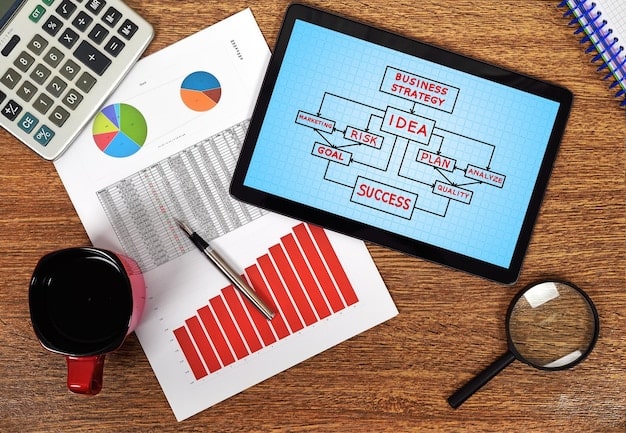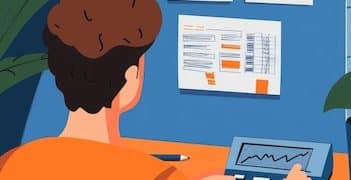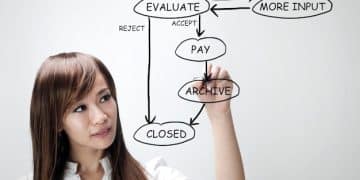Bankruptcy Options: Debt Relief Guide for Chapter 7 & 13

Navigating financial distress can be overwhelming, but understanding different bankruptcy options, specifically Chapter 7 and Chapter 13, provides a structured path toward debt relief and a fresh financial start within the U.S. legal framework.
Facing overwhelming debt can feel like a heavy burden, but the U.S. legal system offers structured paths toward a fresh financial beginning. Exploring Bankruptcy Options: A Comprehensive Guide to Debt Relief Under Chapter 7 and Chapter 13 reveals vital information for those seeking solutions to their financial challenges.
Understanding the Basics of Bankruptcy
Navigating the complexities of financial distress often leads individuals to consider bankruptcy as a viable debt relief strategy. This initial step can be daunting, primarily due to common misconceptions and a general lack of clarity surrounding the process. It’s crucial to approach bankruptcy not as a failure, but as a legal mechanism designed to help individuals and businesses overcome insurmountable debt.
Bankruptcy laws in the United States are federal, meaning they are consistent across all states, though local court rules and practices can vary. The primary goal of bankruptcy is either to liquidate assets to pay off debts (Chapter 7) or to reorganize debts to make them more manageable (Chapter 13), providing debtors with a fresh start and creditors with a structured framework for repayment. Understanding these foundational principles is essential before delving into the specifics of each chapter. The decision to file for bankruptcy is significant and should be made after careful consideration and professional advice.
Eligibility for Bankruptcy Filings
Not everyone qualifies for every type of bankruptcy. Both Chapter 7 and Chapter 13 have specific eligibility criteria that depend largely on income, debt type, and prior bankruptcy filings. For Chapter 7, a “means test” is often applied, comparing the debtor’s income to the median income in their state. If the income is above the median, further calculations are required to determine if there’s sufficient disposable income to pay off a significant portion of unsecured debts, which might disqualify them from Chapter 7 and push them towards Chapter 13.
* Chapter 7 means test: Evaluates if a debtor’s income is low enough to qualify for liquidation.
* Chapter 13 income requirements: Debtors must have a regular income source to propose a repayment plan.
* Debt limits for Chapter 13: There are specific caps on the amount of secured and unsecured debt a debtor can have to qualify.
For Chapter 13, the debtor must have a regular income to fund a repayment plan, and their secured and unsecured debts must not exceed certain limits. These limits are adjusted periodically, so it’s important to consult current figures. Understanding these eligibility hurdles is a critical first step in determining the most appropriate bankruptcy path. Misinterpreting these rules can lead to wasted time and resources, or even the dismissal of a bankruptcy case.
It’s also important to note that certain debts are non-dischargeable in bankruptcy, such as most student loans, recent taxes, and child support obligations. This means that even after a successful bankruptcy filing, these debts will typically remain. Debtors must also complete credit counseling from an approved agency before filing and a financial management course after filing. These requirements underscore the comprehensive nature of bankruptcy, aiming to address both immediate debt relief and long-term financial stability.
Chapter 7 Bankruptcy: Liquidation and A Fresh Start
Chapter 7 bankruptcy is often referred to as “liquidation” bankruptcy because it involves selling off non-exempt assets to pay creditors. This type of bankruptcy is typically favored by individuals with lower incomes who do not have the disposable income to make regular payments on their debts. The primary goal of Chapter 7 is to discharge (eliminate) most unsecured debts, such as credit card debt, medical bills, and personal loans, providing the debtor with a fresh financial start.
The process begins with filing a petition with the bankruptcy court, along with a schedule of assets and liabilities, current income and expenditures, a statement of financial affairs, and a schedule of executory contracts and unexpired leases. Once filed, an “automatic stay” goes into effect, which immediately stops most collection actions against the debtor, including lawsuits, wage garnishments, and collection calls. This provides immediate relief from creditor harassment.
The Role of the Bankruptcy Trustee and Exemptions
Upon filing, a bankruptcy trustee is appointed to oversee the case. The trustee’s main role is to identify and liquidate non-exempt assets to distribute the proceeds among creditors. However, not all assets are subject to liquidation. Both federal law and state laws provide for “exemptions” that protect certain types of property from being sold. These exemptions vary by state, so it’s critical to understand which exemptions apply in your jurisdiction. Common exemptions include:
* Equity in a home (homestead exemption).
* Vehicles up to a certain value.
* Household goods and furnishings.
* Tools of the trade.
* Retirement accounts.
The goal of exemptions is to ensure that a debtor has enough basic necessities to live and work after bankruptcy. If all of a debtor’s assets are exempt, the case is considered a “no-asset” case, and creditors will receive nothing. This is a common outcome in many Chapter 7 filings, especially for individuals with limited assets. The trustee will review the debtor’s financial documents, conduct a meeting of creditors (known as a “341 meeting”) where the debtor must answer questions under oath, and then determine if there are any non-exempt assets to liquidate.
After the 341 meeting, if there are no objections from creditors or the trustee, and all legal requirements are met, the court will issue a discharge order. This order legally releases the debtor from personal liability for most of their debts, meaning creditors can no longer attempt to collect on those specific debts. The entire Chapter 7 process typically takes about 4 to 6 months from filing to discharge, offering a relatively quick path to debt relief. However, certain debts, like student loans, child support, alimony, and some taxes, are generally not dischargeable in Chapter 7.

Chapter 13 Bankruptcy: Reorganization and Repayment Plans
Chapter 13 bankruptcy, also known as “reorganization” bankruptcy, is designed for individuals who have a regular income and wish to repay all or part of their debts over time. Unlike Chapter 7, Chapter 13 does not involve the liquidation of assets. Instead, debtors propose a repayment plan to the court, typically lasting three to five years, during which they make regular payments to a bankruptcy trustee. The trustee then distributes these payments to creditors according to the approved plan.
This option is often suitable for individuals who: have fallen behind on mortgage or car payments but want to keep their assets; have significant non-exempt assets they wish to protect; or do not qualify for Chapter 7 due to their income level. Chapter 13 also offers a broader “super discharge” for some debts that are not dischargeable under Chapter 7, such as certain types of marital debts or debts incurred by fraud.
Developing and Confirming the Repayment Plan
The core of a Chapter 13 case is the repayment plan. This plan must be feasible, meaning the debtor must demonstrate the ability to make the proposed payments consistently. It must also meet certain legal requirements, including treating specific classes of creditors (like secured creditors, priority creditors, and unsecured creditors) according to bankruptcy law. Developing this plan often requires careful budgeting and financial analysis, usually with the assistance of a bankruptcy attorney.
Key aspects of the repayment plan include:
* Secured debts: The plan must propose payments to secured creditors (e.g., mortgage lenders, auto loan providers) that bring the accounts current or pay off the collateral at its fair market value.
* Priority debts: Debts such as recent taxes and child support arrears must generally be paid in full through the plan.
* Unsecured debts: Unsecured creditors (e.g., credit card companies, medical providers) typically receive a portion of what they are owed, ranging from a small percentage to 100%, depending on the debtor’s disposable income and assets.
After the plan is filed, a confirmation hearing is held where the court determines whether to approve the plan. Creditors have the opportunity to object to the plan if they believe it does not comply with the law or is not feasible. Once confirmed, the debtor must strictly adhere to the payment schedule. Failure to do so can result in the case being dismissed or converted to a Chapter 7. Throughout the duration of the plan, the automatic stay remains in effect, protecting the debtor from collection actions.
Upon successful completion of all payments under the plan, the debtor receives a discharge of most remaining unsecured debts. Chapter 13 can be a powerful tool for individuals to save their homes from foreclosure, cars from repossession, and pay off tax debts in a manageable way, while also tackling other unsecured obligations. The duration of the repayment plan can be either three or five years, depending on the debtor’s income relative to the state median.
Comparing Chapter 7 and Chapter 13: Key Differences
Deciding between Chapter 7 and Chapter 13 bankruptcy depends heavily on an individual’s financial situation, income, assets, and specific goals. While both options offer debt relief, their mechanisms, eligibility, and outcomes differ significantly. Understanding these distinctions is paramount for making an informed choice. Chapter 7 is often considered the “fresh start” option, while Chapter 13 is a “reorganization” or “repayment” plan.
Eligibility and Income Considerations
The first major difference lies in eligibility. Chapter 7 is generally for individuals with limited income who cannot afford to pay their debts. The “means test” is the gatekeeper here, determining if the debtor’s income is low enough to qualify for a complete discharge of unsecured debts. If a debtor’s income is above the state’s median and they have disposable income, they may be presumed to have the ability to pay their debts and thus be ineligible for Chapter 7, pushing them towards Chapter 13.
Chapter 13, conversely, requires a regular and stable income because it’s based on a repayment plan. There are also limits on the amount of secured and unsecured debt an individual can have to qualify for Chapter 13. These limits ensure that the repayment plan is manageable within the framework of a consumer bankruptcy. Therefore, individuals with higher incomes or those exceeding the debt limits for Chapter 13 might find themselves unable to file for either type, potentially needing to explore other debt relief options.
Asset Treatment and Debt Discharge
Another critical distinction is how assets are handled. In Chapter 7, non-exempt assets are liquidated by a trustee to pay creditors. Exemptions vary by state, but they protect essential property. If a debtor has significant non-exempt assets, they risk losing them in a Chapter 7 filing. This is a primary reason why some individuals with substantial assets but temporary financial difficulties opt for Chapter 13.
In Chapter 13, debtors retain all their assets, both exempt and non-exempt. Instead of liquidation, the value of non-exempt assets must be accounted for in the repayment plan – meaning unsecured creditors must receive at least as much as they would have received in a Chapter 7 liquidation. This makes Chapter 13 appealing for those who want to protect their property, especially real estate or valuable investments. Regarding debt discharge, Chapter 7 typically discharges most unsecured debts quickly (within a few months). Chapter 13, however, involves a discharge of remaining debts after the successful completion of a three-to-five-year repayment plan. Chapter 13 also offers a broader “super discharge” for certain debts not dischargeable in Chapter 7, such as non-support debts from divorce decrees or debts incurred through fraud, offering a more comprehensive debt resolution in some cases.
Impact of Bankruptcy on Credit and Future Finances
Filing for bankruptcy, whether Chapter 7 or Chapter 13, undeniably has a significant impact on an individual’s credit score and financial standing. It is a serious step with long-term consequences that extend beyond immediate debt relief. While bankruptcy provides a fresh start, it also signals to future creditors that an individual has defaulted on debts in the past, leading to difficulties in obtaining new credit, loans, or even housing.
A Chapter 7 bankruptcy remains on a credit report for up to 10 years from the filing date, while a Chapter 13 bankruptcy remains for up to 7 years from the filing date. During this period, obtaining favorable interest rates on loans, qualifying for mortgages, or even renting an apartment can be challenging. However, it’s important to understand that a low credit score resulting from overwhelming debt might improve faster after bankruptcy than if an individual struggles indefinitely with debt.
Rebuilding Credit After Bankruptcy
Rebuilding credit after bankruptcy is a gradual but achievable process. The key is to demonstrate responsible financial behavior consistently over time. Immediately after discharge, obtaining new credit can be difficult, but secured credit cards are often an excellent starting point. These cards require a deposit, which acts as the credit limit, minimizing the risk for lenders while allowing the debtor to build a positive payment history.
Other strategies for credit rebuilding include:
* Obtaining a secured loan: Similar to secured credit cards, these loans are backed by collateral and can help establish a payment history.
* Becoming an authorized user: If a trusted friend or family member has good credit, becoming an authorized user on their account can leverage their positive payment history.
* Paying bills on time: This is the most crucial step. Timely payments on any outstanding debts, utilities, or new credit accounts are essential for improving a credit score.
* Monitoring credit reports: Regularly checking credit reports for errors and disputing any inaccuracies can help in the rebuilding process.
Over time, as an individual demonstrates consistent financial responsibility, their credit score will begin to recover. It typically takes a few years to see a significant improvement, and patience is key. The ultimate goal is not just to regain access to credit, but to establish healthier financial habits that prevent future debt crises. The financial education components often required in bankruptcy proceedings are designed to assist with this long-term financial management.
The Bankruptcy Process: From Filing to Discharge
The journey through bankruptcy is a structured legal process, guided by federal law and specific court procedures. While the specifics can vary slightly between Chapter 7 and Chapter 13, the general roadmap from initial contemplation to final discharge involves several distinct and crucial steps. Understanding this roadmap can alleviate anxiety and help debtors prepare effectively.
The process often begins with significant contemplation and consultation with a qualified bankruptcy attorney. Attorneys play a vital role in assessing eligibility, advising on the most appropriate chapter, and preparing the extensive paperwork required. This initial phase involves gathering all financial information, including income, assets, debts, and recent financial transactions. Accuracy and completeness in this stage are critical to avoid delays or complications.
Required Documents and Creditor Meeting
After all necessary information is collected, the bankruptcy petition and schedules are prepared and filed with the bankruptcy court. This filing officially commences the bankruptcy case and triggers the “automatic stay,” which halts most collection activities. Following the filing, debtors must complete a mandatory credit counseling course from an approved agency.
A critical step in both Chapter 7 and Chapter 13 cases is the “Meeting of Creditors,” also known as the 341 meeting. This meeting is generally held approximately one month after the petition is filed. Despite its name, creditors often do not attend. The primary attendees are the debtor(s), their attorney (if applicable), and the bankruptcy trustee assigned to the case. During this meeting, the debtor is placed under oath and answers questions from the trustee regarding their financial situation, assets, debts, and the accuracy of the information provided in the bankruptcy petition.
For Chapter 13 cases, beyond the 341 meeting, debtors must also attend a confirmation hearing for their repayment plan, where the court determines if the plan meets legal requirements and should be approved. Throughout the Chapter 13 plan, debtors make regular payments to the trustee, who then disburses funds to creditors. Upon successful completion of the plan or upon the final distribution of assets in a Chapter 7 “no-asset” case, the court issues a discharge order. This order legally releases the debtor from personal liability for eligible debts, marking the end of the bankruptcy process and the beginning of a financial fresh start. However, it’s important to remember that certain debts, such as student loans, most taxes, and child support, are typically not dischargeable.
Alternatives to Bankruptcy and Considerations
While bankruptcy can offer a powerful solution for overwhelming debt, it is not the only option, nor is it suitable for everyone. Before deciding to file, it’s crucial to explore alternatives that might provide relief without the long-term impact on credit that bankruptcy entails. These alternatives can range from informal negotiations with creditors to more structured debt management programs.
One common alternative is debt consolidation, where multiple debts are combined into a single loan, often with a lower interest rate and a single monthly payment. This can simplify repayment and potentially reduce the overall cost of debt. However, it requires a good credit score to qualify for favorable terms and doesn’t reduce the total amount owed, only reorganizes it. Debt management plans (DMPs) offered by non-profit credit counseling agencies are another option. In a DMP, the agency negotiates with creditors on behalf of the debtor to reduce interest rates or waive fees, creating a more manageable repayment schedule.
Understanding Non-Bankruptcy Debt Relief Options
Beyond consolidation and DMPs, there are other strategies individuals might pursue. Debt settlement involves negotiating with creditors to repay a portion of the debt in exchange for forgiving the remainder. This can be complex and risky, as creditors are not obligated to agree, and a partial payment can still severely impact credit. Furthermore, any forgiven debt over a certain amount may be considered taxable income by the IRS.
Foreclosure prevention programs and loan modifications are specific to mortgage debt, aiming to help homeowners avoid losing their homes. These options often involve working directly with lenders to alter loan terms, such as reducing interest rates or extending repayment periods. For those facing temporary financial hardship, these can be viable alternatives to bankruptcy. It’s important to weigh the pros and cons of each alternative carefully, considering the amount and type of debt, income stability, and long-term financial goals. Consulting with a financial advisor or a credit counselor before making any major decisions can provide valuable insight and guidance, helping individuals choose the path most suitable for their unique circumstances.
Ultimately, the decision to pursue bankruptcy or an alternative should be a well-informed one, based on a comprehensive understanding of the financial situation and potential outcomes. There is no one-size-fits-all solution for debt relief, and the best course of action will depend on individual circumstances.

Choosing the Right Bankruptcy Path: A Deliberate Decision
The decision to file for bankruptcy, and specifically which chapter to pursue, is one of the most significant financial choices an individual can make. It’s not a decision to be taken lightly, as it carries substantial implications for credit, assets, and future financial opportunities. Making the right choice requires careful consideration of various factors, including the type and amount of debt, income stability, assets owned, and long-term financial goals.
It’s common for individuals to feel overwhelmed or ashamed when facing such a decision, but bankruptcy laws exist precisely to provide a legal framework for a fresh financial start. Approaching the choice with a rational and informed perspective is crucial. This involves not only understanding the legal aspects of Chapter 7 and Chapter 13 but also evaluating personal circumstances without emotion.
Consulting with Legal and Financial Professionals
The complexity of bankruptcy law and its potential consequences underscores the importance of seeking professional guidance. A qualified bankruptcy attorney is indispensable in navigating the intricate legal requirements, drafting the necessary paperwork, and representing the debtor in court proceedings. An attorney can assess eligibility, explain the nuances of state and federal exemption laws, and advise on the most advantageous chapter for a specific situation. They can also help avoid common pitfalls that could lead to a dismissal of the case or disadvantageous outcomes.
Beyond legal advice, consulting with a financial advisor or credit counselor can provide a broader perspective on financial health. These professionals can help evaluate whether bankruptcy is truly the best option, or if alternatives such as debt consolidation, debt management plans, or debt settlement might be more appropriate. They can also assist in developing a post-bankruptcy financial plan, focusing on budgeting, saving, and rebuilding credit. This holistic approach ensures that not only is immediate debt relief addressed, but that a sustainable path to long-term financial stability is established. The investment in professional advice often pays dividends by avoiding costly mistakes and setting the stage for a more secure financial future. This step-by-step process, guided by experts, transforms a daunting challenge into a manageable and strategic undertaking, empowering individuals to take control of their financial destiny.
| Key Point | Brief Description |
|---|---|
| ⚖️ Chapter 7 | Liquidation bankruptcy for low earners; discharges most unsecured debts quickly. |
| 📈 Chapter 13 | Reorganization bankruptcy with a 3-5 year repayment plan for debtors with regular income. |
| 🛡️ Asset Protection | Chapter 7 may involve asset liquidation; Chapter 13 allows debtors to keep assets. |
| 📊 Credit Impact | Both chapters negatively affect credit but provide a path to financial recovery. |
Frequently Asked Questions About Bankruptcy Options
The automatic stay is a legal injunction that immediately stops most collection actions against a debtor upon filing for bankruptcy. This includes lawsuits, wage garnishments, repossessions, and collection calls, providing an immediate reprieve from creditor harassment.
Generally, student loans are very difficult to discharge in bankruptcy. Debtors must prove “undue hardship,” which is a stringent legal test, often requiring evidence that repayment would prevent them from maintaining a minimal standard of living.
Chapter 7 bankruptcy typically takes about 4 to 6 months from filing to discharge. Chapter 13 bankruptcy, due to its repayment plan, lasts much longer—either three or five years, depending on the debtor’s income.
Not necessarily. While Chapter 7 involves asset liquidation, federal and state laws provide “exemptions” that protect certain types of property, such as a portion of home equity, vehicles, and household goods, preventing them from being sold by the trustee.
The means test determines eligibility for Chapter 7 bankruptcy by comparing a debtor’s income to their state’s median income and calculating their disposable income. It ensures that only those who genuinely cannot afford to repay their debts qualify for liquidation and a complete discharge.
Conclusion
Navigating the complexities of overwhelming debt is a significant challenge, but understanding the options available under U.S. bankruptcy law, particularly Chapter 7 and Chapter 13, provides a clear pathway to financial relief and a fresh start. Each chapter serves a distinct purpose, tailored to different financial circumstances, from complete debt discharge through liquidation to structured repayment plans that allow debtors to retain assets. The decision to file for bankruptcy, while impactful on credit and future financial endeavors, often represents a necessary and positive step towards reclaiming financial stability. By providing a legal framework for addressing unmanageable debt, bankruptcy allows individuals to break free from the cycle of overwhelming obligations, learn new financial habits, and ultimately rebuild their creditworthiness over time. Professional legal and financial guidance is paramount in making an informed decision, ensuring the chosen path aligns with individual circumstances and long-term financial goals.





